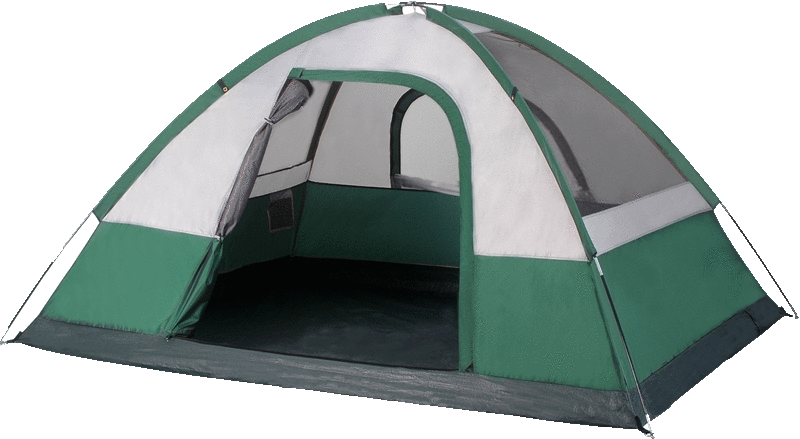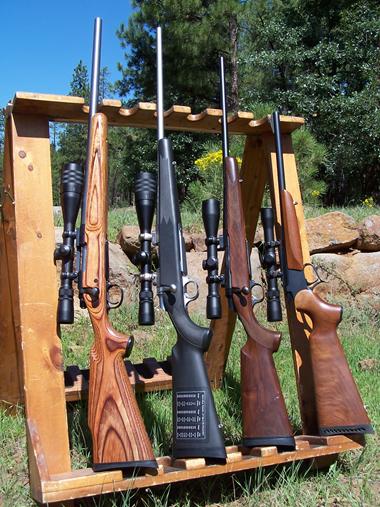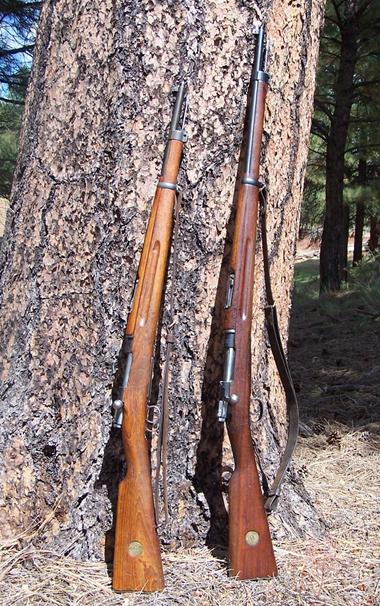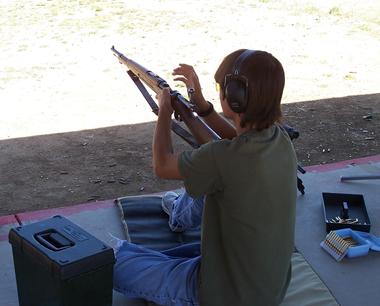
| Articles | Documents | Equipment | Events | Links | Membership | Miscellaneous | Scrapbook | Targets | What's New |
| The Mild Bunch Part 2: 6.5mm | January 2008 | ||||||||||||||||||||||||||||||||||||||||||||||||
| Dan Martinez | |||||||||||||||||||||||||||||||||||||||||||||||||
|
Back in September, I started what I promised was a series on something I called
“The Mild Bunch.” Quickly recapping, I broadly defined The Mild Bunch as the
class of rifle cartridges that sits between the .223 and the .280 Remington
cartridges, not inclusive.
I disqualified all centerfire .22’s as being too small in caliber, and I
disqualified the .30’s as being too large. I also disqualified all cartridges
with case capacity as large or larger than the .30-06.
My reasons for focusing on these cartridges in particular was that first, I was
interested in cartridges capable of taking after deer, which is why I cut off the
centerfire 22’s from consideration. Second, I was interested in comfortable
levels of recoil. One thing I definitely like about rifles is the BOOM and the
shove, but there can be too much of a good thing! The .30-06 is probably my
all-time favorite cartridge, but it’s hard to describe it as mild.
In beginning my series of articles, I started at the top with the 7mm-08, what
I consider to be the most powerful of The Mild Bunch. Today, I’m going to dive
into what’s probably my favorite caliber in The Mild Bunch, the 6.5mm. Presently
there are six rifles in the Martinez armory in 6.5mm, plus one handgun.
The handgun is a Magnum Research Lone Eagle in .260 Remington. That handgun is
frighteningly accurate, capable of firing .4” 3-shot groups at 100 yards off the
bench. Three of the rifles are also in .260 Remington, and those can be seen in
the picture to the right.
One rifle, really a single-shot Thompson-Center carbine, is chambered for 6.5mm
TCU, a wildcat based on the .223 Remington case necked up to 6.5mm.
Finally, two Swedish M96 Mausers in original configuration reside in our collection.
The first is a long M96 made in the Swedish Mauser factory in 1917. I purchased
this one from fellow club member Bert Summer.
The second was originally a long M96 that was made for the Swedes in the German
Mauser factory in Oberndorf in 1900. Starting in 1938, the Swedes started making
new rifles in a shorter size. These rifles were called M38s and have dates of
manufacture of 1938 and later. Additionally, they converted a number of their
older long rifles to short rifle configuration. These shortened long rifles were
called M96/38s, of which, we own an example.
Of course, the Swedish Mausers are chambered for the highly regarded 6.5mm Swede.
This is probably the most popular 6.5mm cartridge in the United States. (True
at the time this story was written, but no longer true today.) It might be
more accurate to call it the 6.5mm Scandinavian, as the adoption of the cartridge
was really a joint effort between the Swedish and Norwegian militaries.
6.5mm TCU
Let’s begin our detailed look at these three cartridges with the smallest of the
three, the very uncommon 6.5mm TCU. With the inside of the neck well lubricated
and using a tapered expander ball, commercial .223 cases easily neck up to 6.5mm
diameter (.264”). Military cases with their thicker case walls can be troublesome,
suffering from a higher percentage of neck splits during the operation. This is
the first step in making 6.5mm TCU ammunition.
Next is seating a heavy bullet long in the case with a starting charge of powder.
Heavy for this little cartridge is 120 grains. It’s not really the weight that we
need for this next step, it’s the length of the heavier bullet. The final shoulder
dimensions are established by “fire-forming” the brass with a bullet which jams
against the lands of the bore. This makes sure that the back of the case is hard
against the breech when the round is fired. The result is that the fire-formed
case is a perfect fit for the chamber of the gun. The shoulder angle of the TCU
is sharper than that of the .223 Rem. The fire-forming step creates the correct
shoulder angle and position in the finished case.
When subsequently reloading 6.5mm TCU cases, case life can be extended greatly if
care is taken not to set the shoulder back during resizing.
The looks of a loaded 6.5 TCU round is at first a little startling, especially the
fire-forming loads. It’s a rather small case with a lot of bullet sticking out of
it. It’s especially noticeable when you compare it side by side with the tiny
bullet sticking only shortly out of a .223.
The scuttlebutt on the 6.5 TCU is that Thompson-Center specs a rather long throat
for this cartridge. As a consequence, the lighter weight bullets, 85 and 100 grain,
may not show the best accuracy since they have such a long jump before engaging the
rifling. On the other hand, there’s not enough case capacity to get 140 grain
bullets up to enough speed for reliable expansion. So for hunting, the sweet spot
seems to be the 120 grain Nosler Ballistic Tip. This bullet is soft enough for
reliable expansion at the 6.5 TCU’s velocity capabilities, and long enough to be
seated close to the lands for accuracy.
The Contender carbine is my son Ben’s javelina rifle. It carries an 18” barrel.
TC chambers very few carbine barrels for this cartridge. Anyone can get one by
placing a special order as we did, it’s just that not many people ask for it in the
long barrel. It is used most often in pistol barrels for silhouette competition.
I now sorta wish that we had ordered a 20” barrel for just a little more velocity.
None of us have ever taken it after deer, but judging by what it does to the little
piggies, I don’t think it would have any trouble on the typical Arizona deer at
distances under 200 yards.
We have only ever tested three loads in the rifle, only for velocity. We’ve never
sat down for a serious bench session with any of these loads. They are:
Note that we’ve never tried the theoretical “perfect bullet,” the 120 grain Nosler
BT. That’s probably because we’ve never taken it after deer, only javelina. The
first load is the one we used back when Ben was a little guy. It’s our minimum
recoil load. Nevertheless, this load had no trouble whatsoever laying low Ben’s
first piggy.
The second load is our maximum velocity load. It’s the load that Ben currently
uses for hunting javelina. It also has accounted for pork in the pot. There was
no noticeable difference in how fast the critters were dispatched between the slower
100 grain load and the faster one at the distances the critters were shot – typical
javelina shooting distances under 100 yards. We’ve tested the fast load on
electronic deer targets up to 200 yards away, where it doesn’t seem to lack for
practical accuracy.
The third load is our fire-forming load. We load this one a little longer than the
hunting loads at 2.725” COL, which puts the bullet into the lands. We usually shoot
this one against water-filled plastic pop bottles for fun practice.
.260 Remington
This of course is my workhorse 6.5mm cartridge. With four firearms chambered for it
in our collection, I load a lot of .260 Remington.
By the way, I keep saying “ours” instead of “my” because a couple of these guns are
much more my boys’ than they are mine these days. The Contender carbine is very much
Ben’s as is the M96/38 Swedish Mauser. The Browning .260 Micro Hunter is very much
Sam’s rifle.
As far as taking game goes, my boys have actually taken more game with the 6.5s than
I have. Ben has taken two javelina with his Contender carbine, and Sam has taken
one doe, one bobcat, one girl elk (a little too young to be called a cow, really),
and now a buck. All with his .260 Browning Micro Hunter. Me? I’ve only taken one
piggy and one turkey. Most of my game-taking seems to happen with some sort of a
.30 cal.
How then is it that I can call the .260 Rem. “my workhorse” cartridge? It’s because
I trip the trigger many more times with a .260 in the chamber than any other caliber.
The reason that is so, is precisely for the reason that I started talking about The
Mild Bunch in the first place: Satisfying BOOM and shove without beating myself
silly! I shoot the .260 a lot in our club matches.
I like telling the story of one year at the club Turkey Shoot, when Gerhard was
running the pistol stage. He put us together into teams and each team had to “hose
down” a bunch of steel critter silhouettes standing in the dirt at various ranges,
as quickly as possible. I figured the proper tool for that might be my 9mm
autopistol for which I had plenty of hi-cap magazines all loaded up. After depleting
all my magazines, having knocked down very few critters, I was in a panic. No time
to reload mags, so I picked up the Lone Eagle single shot pistol in .260 Rem. Much
longer time between shots, but the difference was that every time I pulled the trigger,
CLANG, another critter went down! Soon, they were all down.
Interest seems to have waned in the Handgun Hunters Challenge event, where we go out
into the desert and set up simulated handgun pig hunting situations, so we’re not
holding that shoot this year. But for the last several years, the .260 Lone Eagle
and I have usually finished at the top.
The load I use in the Lone Eagle is also a reduced recoil load. It is the Sierra 85
grain HP over 27.0 grains of XMP-5744. This load does 2300 fps out of the Eagle’s 14”
barrel. It is very pleasant to shoot. This is the load that has twice fired 3-shot
100 yard groups in the .400s. It is also responsible for my only successful turkey
hunt.
Going up in size to the next .260 in our battery is Sam’s Micro Hunter, our single
most successful game-getting 6.5. Successful loads for this gun have been:
From the top, these are the doe load, the buck load, and the elk load. It was the
elk load that also brought Sam’s bobcat to bag.
The next .260 in the lineup is my Stainless Stalker A-Bolt. I originally got this
rifle to compete in Rifle Silhouette matches with the Hassayampa Rod & Gun Club.
I showed up one time with my BOSS-braked .30-06 and they kicked me out. No brakes!
So I got this .260, brakeless, and went back. I did OK, except for the mistake of
knocking down a critter I just missed on. In “official” silhouette matches, you
must move on to the next critter after each shot. Well I was used to how we shoot
in our club matches, where you keep blasting away at the same critter until he’s
down. So my knockdown of that critter didn’t count! That, and I didn’t care for
the time limits.
It’s not that I felt that I had a bad experience at this match, not at all. But
somehow I just never made it back out to another match.
I did take this rifle to Montana with me to hunt deer with Dale Saverud one year.
Opportunity never presented itself on that hunt, though. The rifle did take game
on a javelina hunt. That seemed almost too easy.
The best load I’ve found so far for this rifle is the Sierra 120 grain ProHunter
SP over 38.5 grains of IMR 4064. This gives me about 2775 fps out of the Browning’s
22 inch barrel.
This brings me to my most recent rifle in .260 Rem., a custom-barreled Remington
Model 700 VLS. From the factory it came with a matte black 26” heavy barrel in
some other caliber. But the guy I bought it from had the action trued, rebarreled
with a heavy 22” matte stainless Shilen barrel, and then chambered it for .260
Remington. He says that it is a match chamber, implying tighter tolerances. When
I asked whether the chamber was tight neck, requiring the turning of case necks, he
told me no.
However he did mention that it is short-throated, best suited for long-nosed or
light varmint bullets. Round nose 160 grain bullets won’t work too well in this
rifle. He also included a partially chambered barrel section to use as a gauge for
bullet seating depth. The action is bedded, the barrel free-floated and a Rifle
Basix adjustable trigger installed.
I always wanted a highly breathed-on heavy varminter and when I found this one on
AuctionArms.com (in .260 Rem!) I just had to have it. It was offered for a very
good price considering all that had been done to it.
To tell the truth, I haven’t really worked with this rifle all that much since I
got it. But when Ray Cernansky’s 500 yard rifle match came up last summer, I knew
that this would be the perfect gun for it. One of the classes in the match was
“F Class” for scoped rifles. Since I didn’t have any special loads worked up for
it, I dug into the ammo locker and found 50 rounds of the Nosler 120 grain load
listed above. I just had to seat them a little deeper to accommodate this
chamber. With a score of 437 out of 450 (14 Xs!), I won the match! Great fun.
6.5x55mm Swedish
There are a number of military 6.5mm cartridges, including the 6.5mm Japanese,
the 6.5mm Carcano, and the 6.5x54 Mannlicher-Schoenauer. But stateside by far,
the most popular is the 6.5x55 Swedish Mauser cartridge. I believe that this is
due in no small part to the rifle that was designed to fire the cartridge.
As stated earlier, the 6.5x55 Scandinavian cartridge was designed by a joint
Swedish and Norwegian committee. The Norwegian military adopted a version of
the home-grown Krag-Jorgenson rifle chambered for this cartridge, while the
Swedes adopted the Model 96 Mauser. Very few Norwegian Krags have made it to
these shores, but many thousands of the Swedish Mausers have. That’s the reason
that Americans so closely identify the 6.5x55mm cartridge with the Swedish Mauser.
While the action of the Model 96 Mauser shares many design features with the
much more famous Model 98, it is not quite as strong. However, the Model 96 is
a very lithe and elegant rifle when compared with a Karabiner 98. The Swedish
Mauser is acknowledged as one of the most accurate military surplus rifles
available. To the consternation of military rifle collectors, many Swedish
Mausers have been modified, with varying levels of skill, into very effective
deer hunting rifles here in the states.
Because the Norwegian Krags and the Swedish Mausers are not as strong as the
Model 98, the pressure standard for the 6.5x55 is not as high as modern
cartridges. So even though the 6.5x55 has more case capacity than the .260
Remington, it cannot drive bullets to the same velocities, given the same
length of barrel.
In our collection, the longer Model 96 gets fired very little. But it’s not
leaving the collection any time soon! The shorter Model 96/38 gets taken out
every month or two to compete in Obsolete Bolt Rifle matches. This is the
rifle that Ben competes with. He says that he appreciates the relatively
light recoil of the round during long matches. Notice in the photo below
that there’s nothing but a tee-shirt between that skinny kid and the steel
butt-plate!
Ben’s match loads for the 6.5x55 Mauser are:
Nope, we’ve never chronographed these loads. We’ve kept them comfortably
below max book loads for the 6.5x55. We aren’t shooting these against critters,
we only need to make sure that we can make the bullet fly out to 200 yards, the
max range for any of the Vintage Bolt Rifle matches we’ve entered.
In the next and final part of this series on The Mild Bunch, we’ll talk about
some 6 millimeter cartridges.
© Honeywell Sportsman Club. All rights reserved. | |||||||||||||||||||||||||||||||||||||||||||||||||
The Honeywell Sportsman Club is a small group of shooting and outdoor enthusiasts in the
Phoenix, Arizona area. Our website is ad-free and completely free to use for everyone.
But we do have expenses that we need to cover, such as the web hosting fee and our liability
insurance. If you enjoyed visiting our website, found it useful in some way, or if you enjoyed
reading this story, please consider tipping us through our PayPal donation jar below. Thanks for visiting, and come back soon.
![]()

Articles
Docs
Eqpt
Events
Join
Links
Misc
New
Pix
Targets





